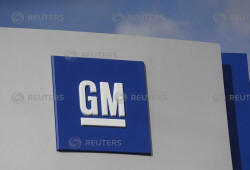Car market collapse outruns GM moves to keep up
 Send a link to a friend
Send a link to a friend
 [November 28, 2018]
By Paul Lienert [November 28, 2018]
By Paul Lienert
DETROIT (Reuters) - General Motors Co's
monumental announcement on Monday that it will close three car assembly
plants in North America and slash its workforce will only partially
close the gap between capacity and demand for the automaker's sedans,
according to a Reuters analysis of industry production and capacity
data.
Sales of traditional passenger cars in North America have been declining
for the past six years and are still withering. After GM ends production
next year at factories in Michigan, Ohio and Ontario, it will still have
four U.S. car plants, all operating at less than 50 percent of rated
capacity, according to figures supplied by LMC Automotive.
In comparison, Detroit-based rivals Ford Motor Co and Fiat Chrysler
Automobiles NV will have one car plant each in North America after 2019.
The Detroit Three are facing rapidly dwindling demand for traditional
passenger cars from U.S. consumers, many of whom have shifted to
crossovers and trucks. Passenger cars accounted for 48 percent of retail
light-vehicle sales in the United States in 2014, according to market
researchers at J.D. Power and Associates. This year, sedans will account
for less than a third of light vehicle sales.

That shift in turn has left most North American car plants operating far
below their rated capacities, while many SUV and truck plants are
running on overtime.
The collapse in passenger-car demand is a challenge for nearly all
automakers in the United States, including Japan's Toyota Motor Corp and
Honda Motor Co Ltd, which have the top-selling models in the compact and
midsize car segments. Toyota executives said last month they are
evaluating the company's U.S. model lineup. But Toyota also plans to
build compact Corolla sedans at a new $1.6 billion factory it is
building in Alabama with partner Mazda Motor Corp.
The obstacles facing GM in its plans to close more auto factories became
apparent on Tuesday as U.S. President Donald Trump threatened to block
payment of government electric vehicle subsidies to GM. While it is not
certain that Trump unilaterally has the power to do that, he made it
clear he intends to use his office to pressure the company to keep open
a small car plant in Ohio that GM says will stop building vehicles in
March.
Asked whether GM's plans to close factories and cut jobs might not solve
the demand problem for its sedans, GM spokeswoman Kimberly Carpenter
said on Tuesday: "We continuously look at our operations for
opportunities to improve our efficiency and capacity utilization. We
believe the actions announced yesterday move us in the right direction
and we will continue to monitor the market and consumer trends and
adjust accordingly."
Shares of the No. 1 U.S. automaker closed 2.5 percent lower at $36.69 on
Tuesday, after rising nearly 5 percent the previous day.
[to top of second column] |

The GM logo is seen at the General Motors Warren Transmission
Operations Plant in Warren, Michigan October 26, 2015.
REUTERS/Rebecca Cook/File Photo

ABANDONMENT ISSUES
GM executives have said they do not intend to abandon cars to the extent that
Ford and FCA have. GM car plants that will remain open include Fairfax, Kansas,
which builds the Chevrolet Malibu and Cadillac XT4 compact SUV. But that plant
is operating at 48 percent of capacity, well below the 80 percent that GM Chief
Executive Mary Barra is targeting as the average for North America.
A GM plant in Lansing, Michigan, that builds the Cadillac ATS and CTS and
Chevrolet Camaro is running at just 33 percent capacity, while the GM Orion
Township, Michigan, facility that builds the Chevrolet Bolt electric car and the
Chevrolet Sonic subcompact runs at 34 percent capacity. A Bowling Green,
Kentucky, plant that builds the Chevrolet Corvette sports car works at just 27
percent of its potential output, according to LMC data.
“Until GM gets more flexibility in its platforms, it will continue to have to
play whack-a-mole with its plants as the market transitions – and it will happen
again,” said LMC analyst Bill Rinna.
In all, the four GM car plants that will remain open have a combined capacity of
more than 800,000 vehicles a year, but are expected to produce only 360,000 cars
this year, according to LMC.
Industry analysts have said the general break-even point for running an assembly
plant profitably is around 80 percent. Barra said on Monday GM's North American
plants are running at 70 percent capacity - including truck and SUV plants that
are working overtime.
Ford plans to end production in March of the Taurus at its Chicago plant, which
also builds the Explorer and Aviator SUVs. That will leave the automaker with
only one U.S. car plant, in Flat Rock, Michigan, which currently builds the Ford
Mustang and the Lincoln Continental. The Mustang is due for a mild redesign
around 2021, but the Continental is scheduled to be phased out then, according
to two sources familiar with the company's plans. Flat Rock is running at just
49 percent of capacity, but Ford has said it plans to add new products to the
plant, including its first automated vehicle, in 2021.

Fiat Chrysler still builds the full-size Chrysler 300 and Dodge Charger and
Challenger at its Brampton, Ontario, plant. Demand for those large cars remains
robust, and the plant is running at nearly 80 percent capacity.
(Reporting by Paul Lienert in Detroit; Editing by Joseph White and Matthew
Lewis)
[© 2018 Thomson Reuters. All rights
reserved.] Copyright 2018 Reuters. All rights reserved. This material may not be published,
broadcast, rewritten or redistributed.
Thompson Reuters is solely responsible for this content. |